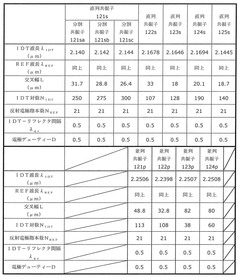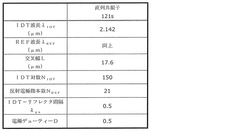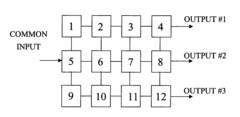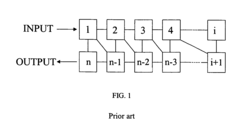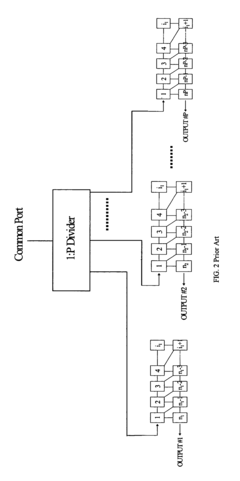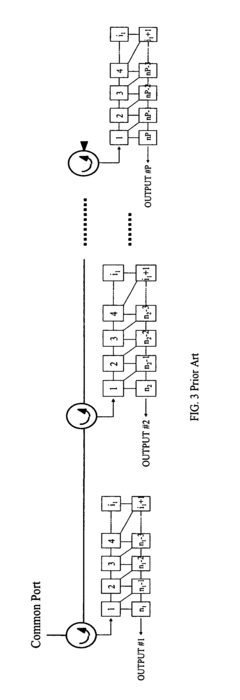Breakthroughs in Multiplexer Functionality for Next-Gen Solutions
JUL 13, 20259 MIN READ
Generate Your Research Report Instantly with AI Agent
Patsnap Eureka helps you evaluate technical feasibility & market potential.
Multiplexer Evolution
The evolution of multiplexers has been a critical factor in the advancement of telecommunications and data transmission technologies. Initially developed in the mid-20th century, multiplexers have undergone significant transformations to meet the ever-increasing demands for higher data rates and more efficient use of communication channels.
In the early stages, frequency-division multiplexing (FDM) was the primary technique used. This method allowed multiple analog signals to be transmitted simultaneously over a single channel by assigning each signal a different carrier frequency. As digital technologies emerged, time-division multiplexing (TDM) became prevalent, enabling the interleaving of digital signals in time slots on a single transmission medium.
The advent of optical fiber communications in the 1970s led to the development of wavelength-division multiplexing (WDM). This technology revolutionized data transmission by allowing multiple optical signals to be carried on a single fiber using different wavelengths of light. WDM systems have since evolved from simple systems carrying a few wavelengths to dense WDM (DWDM) systems capable of transmitting hundreds of wavelengths on a single fiber.
In recent years, the focus has shifted towards more advanced multiplexing techniques to address the exponential growth in data traffic. Spatial division multiplexing (SDM) has emerged as a promising solution, utilizing multiple cores or modes within a single fiber to increase capacity. This approach has led to the development of multi-core fibers (MCF) and few-mode fibers (FMF), pushing the boundaries of transmission capacity.
Concurrently, advancements in digital signal processing have enabled the implementation of sophisticated multiplexing schemes such as orthogonal frequency-division multiplexing (OFDM) and polarization-division multiplexing (PDM). These techniques have significantly improved spectral efficiency and data rates in both wireless and optical communications.
The evolution of multiplexers has also been marked by the integration of intelligent features and software-defined networking (SDN) capabilities. Modern multiplexers are increasingly programmable, allowing for dynamic allocation of bandwidth and adaptive modulation schemes to optimize network performance in real-time.
Looking towards the future, research is focused on developing multiplexers that can support emerging technologies such as 5G and beyond, Internet of Things (IoT), and quantum communications. This includes exploring novel materials and structures for photonic integrated circuits, as well as investigating machine learning algorithms for autonomous network optimization.
In the early stages, frequency-division multiplexing (FDM) was the primary technique used. This method allowed multiple analog signals to be transmitted simultaneously over a single channel by assigning each signal a different carrier frequency. As digital technologies emerged, time-division multiplexing (TDM) became prevalent, enabling the interleaving of digital signals in time slots on a single transmission medium.
The advent of optical fiber communications in the 1970s led to the development of wavelength-division multiplexing (WDM). This technology revolutionized data transmission by allowing multiple optical signals to be carried on a single fiber using different wavelengths of light. WDM systems have since evolved from simple systems carrying a few wavelengths to dense WDM (DWDM) systems capable of transmitting hundreds of wavelengths on a single fiber.
In recent years, the focus has shifted towards more advanced multiplexing techniques to address the exponential growth in data traffic. Spatial division multiplexing (SDM) has emerged as a promising solution, utilizing multiple cores or modes within a single fiber to increase capacity. This approach has led to the development of multi-core fibers (MCF) and few-mode fibers (FMF), pushing the boundaries of transmission capacity.
Concurrently, advancements in digital signal processing have enabled the implementation of sophisticated multiplexing schemes such as orthogonal frequency-division multiplexing (OFDM) and polarization-division multiplexing (PDM). These techniques have significantly improved spectral efficiency and data rates in both wireless and optical communications.
The evolution of multiplexers has also been marked by the integration of intelligent features and software-defined networking (SDN) capabilities. Modern multiplexers are increasingly programmable, allowing for dynamic allocation of bandwidth and adaptive modulation schemes to optimize network performance in real-time.
Looking towards the future, research is focused on developing multiplexers that can support emerging technologies such as 5G and beyond, Internet of Things (IoT), and quantum communications. This includes exploring novel materials and structures for photonic integrated circuits, as well as investigating machine learning algorithms for autonomous network optimization.
Market Demand Analysis
The market demand for advanced multiplexer functionality in next-generation solutions is experiencing significant growth, driven by the increasing complexity and data requirements of modern communication systems. As industries continue to digitize and adopt more sophisticated technologies, the need for efficient data transmission and management becomes paramount.
In the telecommunications sector, the rollout of 5G networks and the anticipated 6G technology are major drivers for multiplexer innovation. These networks require higher bandwidth, lower latency, and increased capacity to handle the exponential growth in data traffic. Multiplexers play a crucial role in optimizing network performance by enabling multiple data streams to be combined and transmitted over a single channel.
The Internet of Things (IoT) ecosystem is another key market segment fueling the demand for advanced multiplexers. With billions of connected devices generating vast amounts of data, there is a pressing need for efficient data aggregation and transmission solutions. Multiplexers that can handle diverse data types and protocols are essential for managing the complex IoT landscape.
In the automotive industry, the trend towards connected and autonomous vehicles is creating a surge in demand for high-performance multiplexers. These devices are critical for managing the numerous sensors, cameras, and communication systems required for advanced driver assistance systems (ADAS) and autonomous driving capabilities.
The data center market is also a significant driver for multiplexer advancements. As cloud computing and big data analytics continue to grow, data centers require increasingly sophisticated multiplexing solutions to manage the massive data flows between servers, storage systems, and network infrastructure.
In the aerospace and defense sectors, there is a growing need for ruggedized and high-reliability multiplexers capable of operating in extreme environments. These industries demand multiplexers that can handle secure communications, sensor data fusion, and real-time information processing for mission-critical applications.
The healthcare industry is emerging as a new frontier for multiplexer applications, particularly in telemedicine and remote patient monitoring. The ability to efficiently transmit and manage multiple streams of patient data, including vital signs, imaging, and video consultations, is becoming increasingly important.
Market analysts project that the global multiplexer market will continue to expand at a compound annual growth rate (CAGR) of over 8% in the coming years. This growth is attributed to the increasing adoption of digital technologies across industries and the ongoing development of communication infrastructure worldwide.
As the demand for higher data rates and more efficient spectrum utilization continues to rise, there is a clear market opportunity for innovative multiplexer solutions that can address these evolving needs. Companies that can develop multiplexers with improved functionality, such as higher channel density, lower power consumption, and enhanced signal integrity, are well-positioned to capture significant market share in this growing sector.
In the telecommunications sector, the rollout of 5G networks and the anticipated 6G technology are major drivers for multiplexer innovation. These networks require higher bandwidth, lower latency, and increased capacity to handle the exponential growth in data traffic. Multiplexers play a crucial role in optimizing network performance by enabling multiple data streams to be combined and transmitted over a single channel.
The Internet of Things (IoT) ecosystem is another key market segment fueling the demand for advanced multiplexers. With billions of connected devices generating vast amounts of data, there is a pressing need for efficient data aggregation and transmission solutions. Multiplexers that can handle diverse data types and protocols are essential for managing the complex IoT landscape.
In the automotive industry, the trend towards connected and autonomous vehicles is creating a surge in demand for high-performance multiplexers. These devices are critical for managing the numerous sensors, cameras, and communication systems required for advanced driver assistance systems (ADAS) and autonomous driving capabilities.
The data center market is also a significant driver for multiplexer advancements. As cloud computing and big data analytics continue to grow, data centers require increasingly sophisticated multiplexing solutions to manage the massive data flows between servers, storage systems, and network infrastructure.
In the aerospace and defense sectors, there is a growing need for ruggedized and high-reliability multiplexers capable of operating in extreme environments. These industries demand multiplexers that can handle secure communications, sensor data fusion, and real-time information processing for mission-critical applications.
The healthcare industry is emerging as a new frontier for multiplexer applications, particularly in telemedicine and remote patient monitoring. The ability to efficiently transmit and manage multiple streams of patient data, including vital signs, imaging, and video consultations, is becoming increasingly important.
Market analysts project that the global multiplexer market will continue to expand at a compound annual growth rate (CAGR) of over 8% in the coming years. This growth is attributed to the increasing adoption of digital technologies across industries and the ongoing development of communication infrastructure worldwide.
As the demand for higher data rates and more efficient spectrum utilization continues to rise, there is a clear market opportunity for innovative multiplexer solutions that can address these evolving needs. Companies that can develop multiplexers with improved functionality, such as higher channel density, lower power consumption, and enhanced signal integrity, are well-positioned to capture significant market share in this growing sector.
Technical Challenges
The current landscape of multiplexer technology presents several significant challenges that need to be addressed for next-generation solutions. One of the primary obstacles is the increasing demand for higher data transmission rates, which puts pressure on existing multiplexer designs to handle more information simultaneously without compromising signal integrity.
Bandwidth limitations pose a substantial hurdle, as traditional multiplexers struggle to accommodate the exponential growth in data traffic. This challenge is particularly acute in telecommunications and data center applications, where the need for efficient data routing and management is paramount. Engineers are grappling with the task of expanding bandwidth capabilities while maintaining low latency and minimizing signal degradation.
Power consumption remains a critical concern, especially as multiplexers are integrated into more compact and mobile devices. The heat generated by high-performance multiplexers can lead to reliability issues and increased cooling requirements, which in turn affects overall system efficiency. Developing energy-efficient multiplexer solutions that can operate at high speeds without excessive power draw is a key technical challenge.
Signal crosstalk and interference present ongoing difficulties, particularly as multiplexer designs become more dense and complex. As signals are packed more tightly together, the risk of electromagnetic interference increases, potentially leading to data errors and reduced system performance. Mitigating these effects while maintaining high-speed operation is a delicate balancing act that engineers must navigate.
The integration of multiplexers with other system components, such as analog-to-digital converters and signal processors, presents its own set of challenges. Ensuring seamless interoperability and optimizing overall system performance requires careful consideration of interface designs and timing synchronization.
Scalability is another significant hurdle, as next-generation solutions demand multiplexers that can easily adapt to varying channel counts and data rates. Developing flexible architectures that can scale efficiently without requiring complete redesigns for different applications is a complex engineering task.
Lastly, the push towards miniaturization in many industries necessitates the development of smaller, more compact multiplexer designs. This reduction in size must be achieved without sacrificing performance or reliability, which presents significant challenges in terms of thermal management and signal integrity preservation.
Bandwidth limitations pose a substantial hurdle, as traditional multiplexers struggle to accommodate the exponential growth in data traffic. This challenge is particularly acute in telecommunications and data center applications, where the need for efficient data routing and management is paramount. Engineers are grappling with the task of expanding bandwidth capabilities while maintaining low latency and minimizing signal degradation.
Power consumption remains a critical concern, especially as multiplexers are integrated into more compact and mobile devices. The heat generated by high-performance multiplexers can lead to reliability issues and increased cooling requirements, which in turn affects overall system efficiency. Developing energy-efficient multiplexer solutions that can operate at high speeds without excessive power draw is a key technical challenge.
Signal crosstalk and interference present ongoing difficulties, particularly as multiplexer designs become more dense and complex. As signals are packed more tightly together, the risk of electromagnetic interference increases, potentially leading to data errors and reduced system performance. Mitigating these effects while maintaining high-speed operation is a delicate balancing act that engineers must navigate.
The integration of multiplexers with other system components, such as analog-to-digital converters and signal processors, presents its own set of challenges. Ensuring seamless interoperability and optimizing overall system performance requires careful consideration of interface designs and timing synchronization.
Scalability is another significant hurdle, as next-generation solutions demand multiplexers that can easily adapt to varying channel counts and data rates. Developing flexible architectures that can scale efficiently without requiring complete redesigns for different applications is a complex engineering task.
Lastly, the push towards miniaturization in many industries necessitates the development of smaller, more compact multiplexer designs. This reduction in size must be achieved without sacrificing performance or reliability, which presents significant challenges in terms of thermal management and signal integrity preservation.
Current Solutions
01 Signal selection and routing
Multiplexers are used for selecting and routing signals from multiple input channels to a single output channel. They allow for efficient data transmission and management in various electronic systems by enabling the selection of specific input signals based on control inputs.- Signal selection and routing: Multiplexers are used to select and route signals from multiple input channels to a single output channel. They allow for efficient data transmission and processing by combining multiple data streams into a single stream. This functionality is crucial in various applications, including telecommunications, digital signal processing, and computer networks.
- Power management and clock distribution: Multiplexers play a role in power management and clock distribution systems. They can be used to select between different clock sources or power modes, enabling dynamic frequency scaling and power optimization in electronic devices. This functionality is particularly important in low-power and energy-efficient designs.
- Optical signal multiplexing: In optical communication systems, multiplexers are used to combine multiple optical signals onto a single fiber. This allows for increased bandwidth and efficient use of optical transmission resources. Optical multiplexers can work with different wavelengths or modes of light to achieve high-capacity data transmission.
- Analog signal multiplexing: Multiplexers are employed in analog circuits to switch between multiple analog input signals. This functionality is useful in applications such as data acquisition systems, sensor interfaces, and audio processing. Analog multiplexers can help reduce the number of analog-to-digital converters required in a system.
- Reconfigurable logic and FPGA applications: Multiplexers are fundamental building blocks in reconfigurable logic devices such as Field-Programmable Gate Arrays (FPGAs). They enable the creation of flexible and adaptable digital circuits by allowing dynamic selection of logic paths and functions. This functionality is essential for implementing complex digital systems and prototyping.
02 Time-division multiplexing
Time-division multiplexing is a technique used in multiplexers to combine multiple data streams into a single signal by allocating time slots to each stream. This method allows for efficient utilization of communication channels and bandwidth in telecommunications and networking applications.Expand Specific Solutions03 Optical multiplexing
Optical multiplexers are used in fiber-optic communication systems to combine multiple optical signals into a single fiber. These devices enable the transmission of multiple wavelengths of light through a single optical fiber, increasing the overall capacity and efficiency of optical networks.Expand Specific Solutions04 Programmable logic and reconfigurable multiplexers
Programmable and reconfigurable multiplexers are used in field-programmable gate arrays (FPGAs) and other programmable logic devices. These multiplexers allow for dynamic configuration of signal routing and logic functions, enabling flexible and adaptable circuit designs.Expand Specific Solutions05 Multiplexer power management and optimization
Techniques for optimizing power consumption and performance in multiplexer designs are crucial for modern electronic systems. This includes implementing power-efficient switching mechanisms, reducing parasitic capacitances, and employing advanced circuit topologies to minimize power dissipation while maintaining high-speed operation.Expand Specific Solutions
Industry Leaders
The multiplexer functionality market for next-generation solutions is in a growth phase, driven by increasing demand for high-performance communication systems. The market size is expanding rapidly, with major players like NXP Semiconductors, Xilinx, and Altera Corp. leading technological advancements. These companies are investing heavily in R&D to develop more efficient and versatile multiplexer solutions. The technology is maturing, with companies like ZTE Corp. and Thales SA integrating advanced multiplexers into their product lines. However, there's still room for innovation, particularly in areas such as power efficiency and miniaturization, where firms like Murata Manufacturing and Sony Group Corp. are making significant strides.
ZTE Corp.
Technical Solution: ZTE has made significant advancements in multiplexer functionality for next-generation solutions, particularly in the realm of 5G and future wireless technologies. They have developed innovative massive MIMO systems with advanced spatial multiplexing capabilities, enabling high-capacity, multi-user communications. ZTE's latest 5G base stations incorporate adaptive beamforming and multi-user MIMO technologies that can dynamically allocate and multiplex resources to multiple users simultaneously, significantly improving spectral efficiency and network capacity[12]. In the optical domain, ZTE has made breakthroughs in elastic optical networks (EON) with flexible-grid wavelength division multiplexing (WDM) technology, allowing for more efficient use of optical spectrum and increased network flexibility[13]. Additionally, ZTE has introduced AI-driven multiplexing algorithms in their network management systems, which can dynamically optimize resource allocation and network performance based on real-time traffic patterns and user demands[14].
Strengths: Strong expertise in wireless and optical communications, with a focus on practical, deployable solutions for next-generation networks. Weaknesses: Geopolitical concerns may limit adoption of their technologies in some markets.
NEC Corp.
Technical Solution: NEC has made significant strides in multiplexer functionality for next-generation solutions, particularly in the areas of 5G, 6G, and beyond. They have developed advanced Massive MIMO (Multiple-Input Multiple-Output) systems that utilize sophisticated spatial multiplexing techniques to dramatically increase network capacity and spectral efficiency. NEC's 5G massive MIMO antennas can support up to 128 transmit/receive elements, enabling high-density multiplexing of user signals[9]. In the optical domain, NEC has pioneered breakthroughs in space division multiplexing (SDM) using multi-core fibers, demonstrating transmission capacities exceeding 1 petabit per second over a single fiber[10]. Additionally, NEC has made advancements in quantum-inspired multiplexing algorithms for optimization problems, which can be applied to various fields including finance, logistics, and drug discovery[11].
Strengths: Strong position in both wireless and optical communications, with cutting-edge technologies applicable to future network infrastructures. Weaknesses: Some technologies, particularly in quantum-inspired computing, are still in early stages of practical application.
Key Innovations
Multiplexer, high-frequency front end circuit, and communication device
PatentWO2018003297A1
Innovation
- A quadplexer design is implemented with a series resonator composed of multiple split resonators having different design parameters, including IDT electrode capacitances and reflector configurations, to cancel out ripples within the passband, thereby suppressing ripple effects across connected filters.
Generalized multiplexing network
PatentInactiveUS8008990B2
Innovation
- A new topology using asynchronously-tuned coupled resonators with a common port and multiple input/output channels, eliminating the need for external power dividers and manifold networks, and employing a generalized coupling matrix for optimized coupling coefficients to maximize channel selectivity and minimize reflection and transmission losses.
Standardization Efforts
Standardization efforts in the field of multiplexer functionality for next-generation solutions have become increasingly crucial as the technology continues to evolve rapidly. These efforts aim to establish common protocols, interfaces, and performance metrics across the industry, ensuring interoperability and facilitating seamless integration of multiplexer technologies into various applications.
One of the primary focuses of standardization has been the development of unified specifications for multiplexer interfaces. Industry consortia and standards organizations have been working collaboratively to define common electrical and physical characteristics for multiplexer inputs and outputs. This standardization enables manufacturers to design compatible components and systems, reducing integration challenges and accelerating time-to-market for new products.
Performance benchmarking has also been a key area of standardization efforts. Establishing standardized metrics for evaluating multiplexer efficiency, signal integrity, and power consumption allows for meaningful comparisons between different solutions. These benchmarks help system designers make informed decisions when selecting multiplexers for specific applications, while also driving innovation among manufacturers to improve their offerings.
Interoperability testing and certification programs have emerged as essential components of the standardization process. These programs ensure that multiplexers from different vendors can work together seamlessly within complex systems. By adhering to standardized testing procedures, manufacturers can demonstrate compliance with industry norms and build trust among customers and partners.
The standardization of multiplexer control protocols has been another significant focus. Defining common command sets and communication interfaces enables easier integration of multiplexers into diverse control systems and software environments. This standardization simplifies system design and reduces the need for custom interfaces, ultimately lowering development costs and improving overall system reliability.
As multiplexer technology continues to advance, standardization efforts are also addressing emerging challenges such as high-frequency operation, increased channel density, and advanced signal processing capabilities. Working groups within standards organizations are developing guidelines and specifications to ensure that next-generation multiplexers can meet the demands of cutting-edge applications in telecommunications, data centers, and high-performance computing.
The ongoing collaboration between industry leaders, research institutions, and standards bodies is crucial for the success of these standardization efforts. Regular meetings, workshops, and technical conferences provide platforms for stakeholders to share insights, discuss challenges, and collectively shape the future of multiplexer technology standards. This collaborative approach ensures that standardization keeps pace with technological advancements and remains relevant to the evolving needs of the industry.
One of the primary focuses of standardization has been the development of unified specifications for multiplexer interfaces. Industry consortia and standards organizations have been working collaboratively to define common electrical and physical characteristics for multiplexer inputs and outputs. This standardization enables manufacturers to design compatible components and systems, reducing integration challenges and accelerating time-to-market for new products.
Performance benchmarking has also been a key area of standardization efforts. Establishing standardized metrics for evaluating multiplexer efficiency, signal integrity, and power consumption allows for meaningful comparisons between different solutions. These benchmarks help system designers make informed decisions when selecting multiplexers for specific applications, while also driving innovation among manufacturers to improve their offerings.
Interoperability testing and certification programs have emerged as essential components of the standardization process. These programs ensure that multiplexers from different vendors can work together seamlessly within complex systems. By adhering to standardized testing procedures, manufacturers can demonstrate compliance with industry norms and build trust among customers and partners.
The standardization of multiplexer control protocols has been another significant focus. Defining common command sets and communication interfaces enables easier integration of multiplexers into diverse control systems and software environments. This standardization simplifies system design and reduces the need for custom interfaces, ultimately lowering development costs and improving overall system reliability.
As multiplexer technology continues to advance, standardization efforts are also addressing emerging challenges such as high-frequency operation, increased channel density, and advanced signal processing capabilities. Working groups within standards organizations are developing guidelines and specifications to ensure that next-generation multiplexers can meet the demands of cutting-edge applications in telecommunications, data centers, and high-performance computing.
The ongoing collaboration between industry leaders, research institutions, and standards bodies is crucial for the success of these standardization efforts. Regular meetings, workshops, and technical conferences provide platforms for stakeholders to share insights, discuss challenges, and collectively shape the future of multiplexer technology standards. This collaborative approach ensures that standardization keeps pace with technological advancements and remains relevant to the evolving needs of the industry.
Energy Efficiency
Energy efficiency has become a critical focus in the development of next-generation multiplexer solutions. As data transmission demands continue to escalate, the need for more power-efficient multiplexing technologies has become paramount. Recent breakthroughs in this area have significantly improved the energy performance of multiplexers, paving the way for more sustainable and cost-effective communication systems.
One of the key advancements in multiplexer energy efficiency is the implementation of advanced semiconductor materials. Gallium nitride (GaN) and silicon carbide (SiC) have emerged as promising alternatives to traditional silicon-based components. These wide-bandgap semiconductors offer superior electron mobility and thermal conductivity, allowing for higher switching frequencies and reduced power losses. As a result, multiplexers utilizing these materials can operate at higher temperatures with improved efficiency, reducing the need for extensive cooling systems.
Another significant development is the integration of intelligent power management systems within multiplexer designs. These systems employ sophisticated algorithms to dynamically adjust power consumption based on real-time traffic demands. By optimizing power allocation across different channels and adapting to varying load conditions, these smart multiplexers can achieve substantial energy savings without compromising performance.
The miniaturization of multiplexer components has also contributed to enhanced energy efficiency. Through advanced fabrication techniques and innovative circuit designs, manufacturers have successfully reduced the size and power requirements of multiplexer units. This not only leads to direct energy savings but also allows for more compact and efficient overall system designs, further reducing power consumption in related components and cooling infrastructure.
Advancements in optical multiplexing technologies have opened new avenues for energy-efficient data transmission. Wavelength division multiplexing (WDM) systems, in particular, have seen significant improvements in their energy performance. The development of low-power tunable lasers and high-sensitivity photodetectors has enabled WDM systems to operate with reduced power requirements while maintaining high data throughput.
The integration of machine learning and artificial intelligence into multiplexer control systems represents another frontier in energy efficiency. These technologies enable predictive maintenance, optimized routing, and adaptive power management, further reducing energy waste and extending the operational lifespan of multiplexer components. By anticipating network demands and preemptively adjusting system parameters, AI-enhanced multiplexers can maintain peak efficiency under diverse operating conditions.
As the industry continues to push the boundaries of multiplexer functionality, energy efficiency remains a key driver of innovation. These advancements not only contribute to the reduction of operational costs but also align with global initiatives for sustainable technology development. The ongoing research in this field promises to deliver even more energy-efficient multiplexing solutions, supporting the ever-growing demands of next-generation communication networks.
One of the key advancements in multiplexer energy efficiency is the implementation of advanced semiconductor materials. Gallium nitride (GaN) and silicon carbide (SiC) have emerged as promising alternatives to traditional silicon-based components. These wide-bandgap semiconductors offer superior electron mobility and thermal conductivity, allowing for higher switching frequencies and reduced power losses. As a result, multiplexers utilizing these materials can operate at higher temperatures with improved efficiency, reducing the need for extensive cooling systems.
Another significant development is the integration of intelligent power management systems within multiplexer designs. These systems employ sophisticated algorithms to dynamically adjust power consumption based on real-time traffic demands. By optimizing power allocation across different channels and adapting to varying load conditions, these smart multiplexers can achieve substantial energy savings without compromising performance.
The miniaturization of multiplexer components has also contributed to enhanced energy efficiency. Through advanced fabrication techniques and innovative circuit designs, manufacturers have successfully reduced the size and power requirements of multiplexer units. This not only leads to direct energy savings but also allows for more compact and efficient overall system designs, further reducing power consumption in related components and cooling infrastructure.
Advancements in optical multiplexing technologies have opened new avenues for energy-efficient data transmission. Wavelength division multiplexing (WDM) systems, in particular, have seen significant improvements in their energy performance. The development of low-power tunable lasers and high-sensitivity photodetectors has enabled WDM systems to operate with reduced power requirements while maintaining high data throughput.
The integration of machine learning and artificial intelligence into multiplexer control systems represents another frontier in energy efficiency. These technologies enable predictive maintenance, optimized routing, and adaptive power management, further reducing energy waste and extending the operational lifespan of multiplexer components. By anticipating network demands and preemptively adjusting system parameters, AI-enhanced multiplexers can maintain peak efficiency under diverse operating conditions.
As the industry continues to push the boundaries of multiplexer functionality, energy efficiency remains a key driver of innovation. These advancements not only contribute to the reduction of operational costs but also align with global initiatives for sustainable technology development. The ongoing research in this field promises to deliver even more energy-efficient multiplexing solutions, supporting the ever-growing demands of next-generation communication networks.
Unlock deeper insights with Patsnap Eureka Quick Research — get a full tech report to explore trends and direct your research. Try now!
Generate Your Research Report Instantly with AI Agent
Supercharge your innovation with Patsnap Eureka AI Agent Platform!
